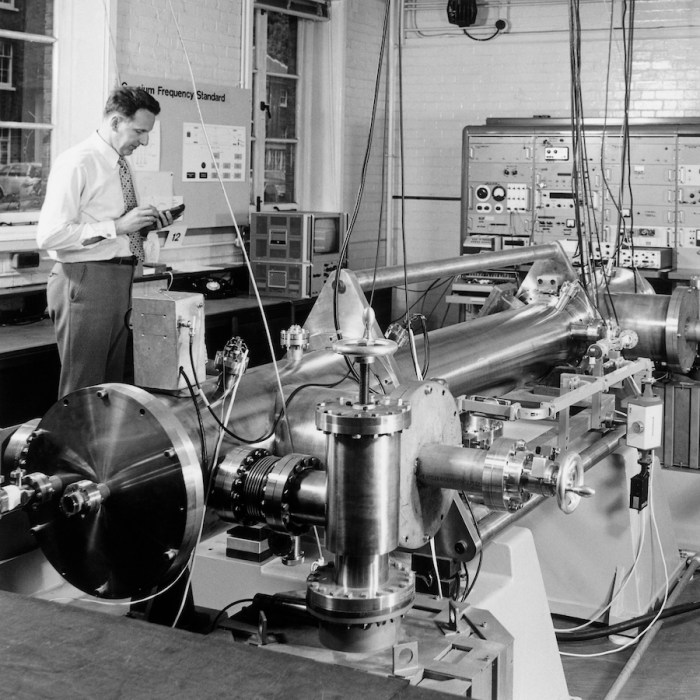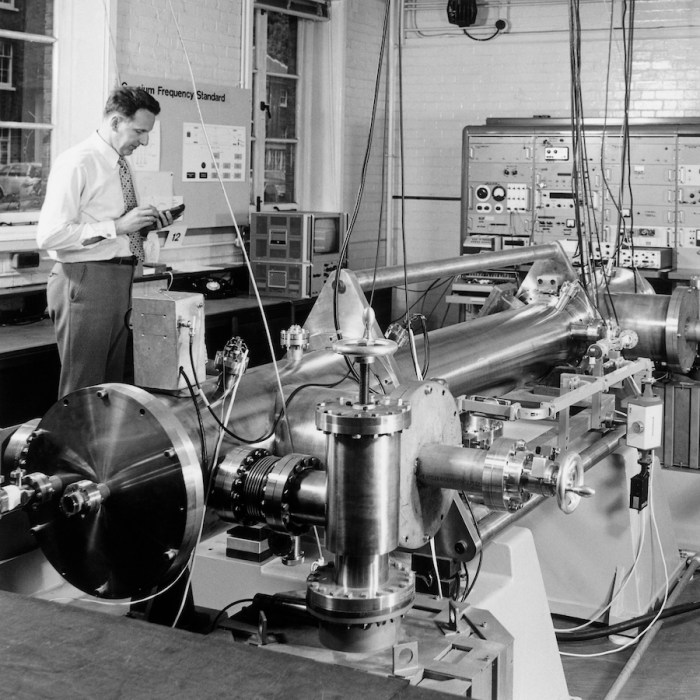Oxford physicists enlist atomic clocks in the hunt for dark matter – Oxford physicists are using atomic clocks in a groundbreaking attempt to detect dark matter, a mysterious substance that makes up a significant portion of the universe but doesn’t interact with light. This innovative approach leverages the incredible precision of atomic clocks to search for subtle variations in the gravitational field, which could be caused by the presence of dark matter.
Atomic clocks, known for their remarkable accuracy in measuring time, can be used to detect minute changes in the gravitational field. This is because the rate at which an atomic clock ticks is affected by the strength of the gravitational field.
If dark matter is present, it would create a localized gravitational field, potentially causing a slight variation in the ticking rate of the atomic clocks. By carefully analyzing these variations, physicists hope to gain insights into the nature of dark matter.
The Nature of Dark Matter
Dark matter is a hypothetical form of matter that does not interact with light, making it invisible to telescopes. It is thought to make up a significant portion of the universe’s mass, far exceeding the mass of all visible matter.
While we cannot directly observe dark matter, its existence is inferred from its gravitational effects on visible matter.
Evidence for Dark Matter
Several lines of evidence point to the existence of dark matter.
Galaxy Rotation Curves
Galaxies rotate faster than expected based on the visible matter they contain. This discrepancy can be explained by the presence of a massive, invisible halo of dark matter surrounding the galaxy. The gravitational pull of this dark matter halo provides the extra force needed to keep the outer stars in orbit at their observed speeds.
Gravitational Lensing
Light bends around massive objects, a phenomenon known as gravitational lensing. The bending of light from distant galaxies by intervening massive objects, like clusters of galaxies, can be used to map the distribution of mass. Observations of gravitational lensing reveal that there is much more mass present than can be accounted for by the visible matter alone, suggesting the presence of dark matter.
Cosmic Microwave Background Radiation
The cosmic microwave background radiation (CMB) is a faint afterglow of the Big Bang. Analysis of the CMB reveals that the universe’s early structure was determined by the distribution of matter and energy. The observed patterns in the CMB suggest that the universe contains a significant amount of dark matter, contributing to its overall density and influencing the growth of large-scale structures.
Theoretical Candidates for Dark Matter
Various theoretical candidates for dark matter have been proposed, each with its own set of properties and interactions.
Weakly Interacting Massive Particles (WIMPs)
WIMPs are hypothetical particles that interact weakly with ordinary matter. They are predicted by some extensions of the Standard Model of particle physics. WIMPs are considered a leading candidate for dark matter due to their predicted abundance and interaction properties.
Axions
Axions are hypothetical particles proposed to solve a problem in particle physics called the strong CP problem. They are very light and interact very weakly with ordinary matter. While axions have not been directly detected, they are a promising dark matter candidate.
Sterile Neutrinos
Sterile neutrinos are hypothetical particles that do not interact with the weak force, unlike ordinary neutrinos. They are heavier than ordinary neutrinos and could be a component of dark matter.
Atomic Clocks and Dark Matter Detection

Atomic clocks, renowned for their exceptional precision in measuring time, have become powerful tools in the quest to understand the enigmatic nature of dark matter. These clocks, based on the unwavering oscillations of atoms, can detect minute variations in the gravitational field, offering a unique avenue for probing the presence of this elusive substance.
Atomic Clocks and Time Measurement
Atomic clocks, unlike traditional timekeeping devices, rely on the inherent properties of atoms to define time. They harness the precise frequencies at which atoms absorb or emit electromagnetic radiation. The most accurate atomic clocks utilize cesium atoms, which oscillate at a frequency of 9,192,631,770 cycles per second.
This frequency serves as the fundamental unit of time, defining one second. The remarkable precision of atomic clocks stems from the intrinsic stability of atomic transitions, ensuring that the oscillations remain consistent over extended periods.
Detecting Gravitational Variations with Atomic Clocks
The profound connection between gravity and time, as described by Einstein’s theory of general relativity, provides the foundation for using atomic clocks to detect subtle gravitational variations. The theory posits that gravity can warp spacetime, causing time to flow at different rates in regions with varying gravitational strengths.
A clock placed in a stronger gravitational field will tick slower compared to a clock in a weaker field. This phenomenon, known as gravitational time dilation, offers a means to detect the presence of massive objects, including dark matter, through their influence on the local gravitational field.
Oxford Physicists’ Approach
Oxford physicists have devised an innovative technique to leverage atomic clocks in their pursuit of dark matter. Their approach involves comparing the timekeeping of two atomic clocks placed at different locations, carefully chosen to maximize the potential for detecting gravitational variations induced by dark matter.
By analyzing any discrepancies in the time measurements, they aim to pinpoint the presence of dark matter and gain insights into its distribution and properties.
The Search for Dark Matter
The hunt for dark matter remains a fundamental challenge in modern physics. While its gravitational effects are evident in the rotation of galaxies and the formation of large-scale structures in the universe, its composition remains a mystery. Atomic clocks, with their unparalleled precision, offer a novel approach to this enduring enigma, potentially revealing the elusive nature of dark matter and its impact on the fabric of spacetime.
The Experiment and its Setup: Oxford Physicists Enlist Atomic Clocks In The Hunt For Dark Matter
The Oxford physicists’ experiment leverages the remarkable precision of atomic clocks to search for dark matter interactions. The experiment is designed to detect subtle shifts in the ticking rate of these clocks, potentially caused by the presence of dark matter particles.The experiment’s setup is meticulously chosen to maximize its sensitivity to these potential interactions.
The Atomic Clocks
The experiment employs two types of atomic clocks: strontium optical lattice clocks and cesium fountain clocks. Strontium clocks are known for their exceptional accuracy, with the potential to measure time intervals with a precision of one part in 10 18.
Cesium fountain clocks, while less precise, provide a crucial reference point for comparison.
Location of the Experiment
The experiment is located deep underground at the Boulby Mine in the UK. This location offers several advantages:
- Reduced Cosmic Ray Interference:The deep underground location significantly reduces the background noise from cosmic rays, which can interfere with the delicate measurements of the atomic clocks.
- Stable Environment:The mine provides a stable and temperature-controlled environment, crucial for maintaining the precision of the atomic clocks.
- Isolation from External Disturbances:The underground location minimizes vibrations and other external disturbances that could affect the experiment’s sensitivity.
Experimental Design
The experiment is designed to detect any minute changes in the ticking rate of the atomic clocks that might be caused by interactions with dark matter particles. The key elements of the experimental setup include:
- Two Atomic Clocks:The experiment uses two atomic clocks, one strontium optical lattice clock and one cesium fountain clock. The strontium clock is expected to be more sensitive to dark matter interactions, while the cesium clock serves as a reference point.
- Ultra-Stable Oscillator:The atomic clocks are synchronized to an ultra-stable oscillator, ensuring that any observed changes in their ticking rates are not due to variations in the oscillator’s frequency.
- Shielding and Isolation:The atomic clocks are carefully shielded from external disturbances, such as magnetic fields and temperature fluctuations, to minimize noise and enhance the experiment’s sensitivity.
Sensitivity and Potential for Dark Matter Detection
The experiment is designed to be sensitive to dark matter interactions with a mass range of 10 -22to 10 -16eV. This range encompasses several theoretical dark matter candidates, including axions and sterile neutrinos. The experiment’s expected sensitivity is based on the precision of the atomic clocks and the carefully controlled environment.The experiment is expected to achieve a sensitivity of 10 -22eV, which would make it one of the most sensitive searches for dark matter interactions to date.
If successful, this experiment could provide groundbreaking insights into the nature of dark matter and its interactions with ordinary matter.
Do not overlook explore the latest data about wind turbines need critical end of life planning.
Potential Implications of the Research
The potential implications of successfully detecting dark matter using atomic clocks are far-reaching and could revolutionize our understanding of the universe. Such a discovery would not only confirm the existence of dark matter, but also provide valuable insights into its nature and its role in shaping the cosmos.
Impact on Our Understanding of the Universe, Oxford physicists enlist atomic clocks in the hunt for dark matter
The successful detection of dark matter would be a monumental achievement in physics, confirming its existence and shedding light on its elusive nature. It would provide the first direct evidence of this mysterious substance that accounts for approximately 85% of the matter in the universe.
This discovery would have profound implications for our understanding of the universe’s structure, evolution, and the nature of gravity.
“The detection of dark matter would be a transformative event in physics, opening a new window into the fundamental nature of the universe.”
- Understanding the Nature of Dark Matter:By directly detecting dark matter, scientists could determine its properties, such as its mass, interaction strength, and particle composition. This knowledge would be crucial for developing a complete understanding of the universe and its evolution.
- Reconciling Gravity and Dark Matter:Dark matter’s gravitational influence is evident in the rotation of galaxies and the distribution of matter in the universe. However, the nature of this interaction remains a mystery. Detecting dark matter would provide valuable insights into how gravity interacts with this mysterious substance, potentially leading to a more unified understanding of gravity and the universe.
- Implications for Cosmology:The discovery would provide crucial information about the early universe, the formation of galaxies, and the distribution of matter on large scales. This knowledge would be essential for refining our understanding of the universe’s history and evolution.
Challenges and Future Directions

While this novel approach to dark matter detection holds great promise, there are several challenges and limitations that need to be addressed. These challenges range from the sensitivity of the atomic clocks to the potential for background noise that could mimic the signal of dark matter interactions.
Advancements in Atomic Clock Technology
The sensitivity of the atomic clocks is crucial for detecting the subtle shifts in time caused by dark matter interactions. Improvements in atomic clock technology are therefore essential for enhancing the sensitivity of this detection method.
- One promising avenue for improvement is the development of even more precise atomic clocks, such as optical atomic clocks, which are based on transitions between energy levels in atoms that are much higher than those used in microwave atomic clocks.
These clocks have the potential to be orders of magnitude more precise than current microwave clocks, significantly increasing the sensitivity of the dark matter search.
- Another potential improvement is the development of atomic clocks that are less susceptible to environmental noise. This could involve using more stable and isolated atomic ensembles, or developing new methods for shielding the clocks from external disturbances.
Alternative Experimental Methods
While the use of atomic clocks represents a novel and promising approach to dark matter detection, it is important to explore other experimental methods as well.
- For example, direct detection experiments, which aim to directly detect the interaction of dark matter particles with ordinary matter, continue to be refined and improved. These experiments often employ highly sensitive detectors shielded from background noise, and they are constantly being made more sensitive to detect fainter signals.
- Another approach is to search for indirect evidence of dark matter interactions, such as the annihilation of dark matter particles, which could produce observable signals in cosmic rays or gamma rays. These indirect detection experiments are also being actively pursued, with new telescopes and detectors being built to improve their sensitivity.
Collaboration and Interdisciplinary Research
The search for dark matter is a challenging endeavor that requires the expertise and resources of researchers from various disciplines. Collaboration between different research groups and institutions is therefore essential to advance this field.
- For example, collaborations between physicists, astronomers, and cosmologists are crucial for interpreting the results of dark matter searches and for developing new theoretical models of dark matter.
- Moreover, collaborations between experimentalists and theorists are essential for designing and interpreting the results of dark matter experiments. This type of collaboration can help to ensure that the experiments are optimized for detecting dark matter and that the results are properly understood.



